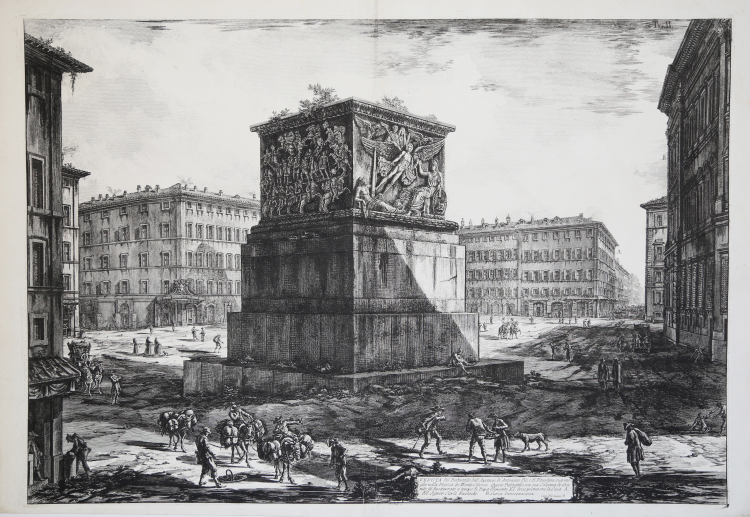




| Reference: | S39009 |
| Author | Giovan Battista PIRANESI |
| Year: | 1776 ca. |
| Zone: | Montecitorio |
| Measures: | 700 x 490 mm |



| Reference: | S39009 |
| Author | Giovan Battista PIRANESI |
| Year: | 1776 ca. |
| Zone: | Montecitorio |
| Measures: | 700 x 490 mm |
Etching and engraving, ca. 1776-79, signed in plate at lower right.
Magnificent proof, rich in tone, impressed on contemporary laid paper without watermark, with margins, in perfect condition.
The engraving depicts today's Piazza Montecitorio, the place where, in antiquity, was located the Ustrinum, a building dedicated to the cremation of emperors and their family: in particular, this belonged to Emperor Antoninus Pius and his wife Faustina. Opposite the north facade of the Ustrinum was the Antonine Column, the base of which, made of white marble, is today located in the Vatican, together with the fragment of the column with the inscription. The column was found in 1703, during the pontificate of Clement XI, near the garden of the convent of the Fathers of the Mission. Initially the pontiff thought of raising it up and placing it in front of the Trevi Fountain, but then the idea was abandoned because the column was too badly damaged and its remains piled up next to Palazzo Montecitorio on Via della Missione. In 1789, under the pontificate of Pius VI, it was decided to use what remained of the column to restore the solar obelisk of Augustus in Montecitorio Square. The obelisk of Psammeticus II, from the Egyptian city of Heliopolis, brought to Rome in 10 B.C. by Emperor Augustus, and placed as the gnomon of the sundial in the Campus Martius. Collapsed between the 9th and 11th centuries, it was later erected in its present location by architect Giovanni Antinori in 1792, during the pontificate of Pius VI.
The work is part of the uncommon work Trofeo o sia Magnifica Colonna Coclide di marmo composto di grossi stone ove si veggono scoltamenti le due guerre daciche fatte, da Trajano inalzata nel mezzo del Gran Foro eretto al medesimo imperadore per ordine del senato e popolo romano doppo i suoi trionfi, printed by Piranesi between 1774 and 1779.
Bibliografia
H. Focillon, Giovan Battista Piranesi 1720-1778 (1918): n. 573; J. Wilton-Ely, Giovan Battista Piranesi, The complete etchings (1994): n. 713.
Giovan Battista PIRANESI (Mogliano Veneto 1720 - Roma 1778)
|
Italian etcher, engraver, designer, architect, archaeologist and theorist. He is considered one of the supreme exponents of topographical engraving, but his lifelong preoccupation with architecture was fundamental to his art. Although few of his architectural designs were executed, he had a seminal influence on European Neo-classicism through personal contacts with architects, patrons and visiting artists in Rome over the course of nearly four decades. His prolific output of etched plates, which combined remarkable flights of imagination with a strongly practical understanding of ancient Roman technology, fostered a new and lasting perception of antiquity. He was also a designer of festival structures and stage sets, interior decoration and furniture, as well as a restorer of antiquities. The interaction of this rare combination of activities led him to highly original concepts of design, which were advocated in a body of influential theoretical writings. The ultimate legacy of his unique vision of Roman civilization was an imaginative interpretation and re-creation of the past, which inspired writers and poets as much as artists and designers.
|
Giovan Battista PIRANESI (Mogliano Veneto 1720 - Roma 1778)
|
Italian etcher, engraver, designer, architect, archaeologist and theorist. He is considered one of the supreme exponents of topographical engraving, but his lifelong preoccupation with architecture was fundamental to his art. Although few of his architectural designs were executed, he had a seminal influence on European Neo-classicism through personal contacts with architects, patrons and visiting artists in Rome over the course of nearly four decades. His prolific output of etched plates, which combined remarkable flights of imagination with a strongly practical understanding of ancient Roman technology, fostered a new and lasting perception of antiquity. He was also a designer of festival structures and stage sets, interior decoration and furniture, as well as a restorer of antiquities. The interaction of this rare combination of activities led him to highly original concepts of design, which were advocated in a body of influential theoretical writings. The ultimate legacy of his unique vision of Roman civilization was an imaginative interpretation and re-creation of the past, which inspired writers and poets as much as artists and designers.
|